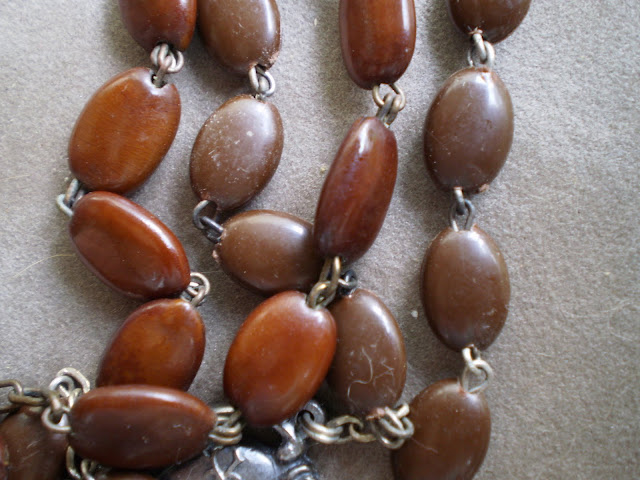Here are two vintage rosaries made of spina Christi beads, the seeds from a thorny plant said to be what Christ's Crown of Thorns was made of. Most information points to these beads being from the Zizyphus spina-christi plant, native to the Middle East. But, one rosary is made from the actual seeds, while the other is made of plastic beads produced to resemble spina Christi beads. Can you tell which is which?
The beads on the left are real, while the ones on the right are plastic. The biggest clue is the uniformity of the shape of the plastic beads. Looking closely (but not shown in the pictures), you can see a little line from the mold that the beads were formed in running along the outside of each bead. Compare the variations in color in the beads on the left, the richer shine and the difference in shapes. The holes in plastic beads will always be right at the top and bottom of the beads, whereas the holes in the actual seeds may be a little off center.
Another clue is the plastic beads will lay perfectly flat. The variations in the size and shape of the real beads generally prevent them from all laying flat.
Here they are jumbled together- can you see the difference now?
Another clue might be the age of the rosary based on materials. The center of the real seed rosary is an old Art Deco style and you can see the brass beneath the silver plating. The center on the right is made of some kind of white metal, possibly pewter, commonly used in the last half of the 20th century. Although, dating a rosary does not guarantee it has authentic spina Christi beads, generally, the older the rosary, the more likely the seeds will be real.
Hopefully, this will help you in your rosary collecting. Remember, there really is nothing wrong with plastic, although, I must admit, I have a real aversion to it!
Find a wonderful selection of antique and vintage rosaries on The Sacred Bead. I am always very careful with describing rosaries, their age and what they are made of. If I don't know or am not sure, I'll always state that.
I will be covering many aspects of collecting antique rosaries in my blogs. Symbology, materials, origins, and other issues the antique rosary lover may be curious about will all be discussed. Each blog will feature a rosary from The Sacred Bead or a private collection. You can visit The Sacred Bead at www.thesacredbead.com
Subscribe to:
Post Comments (Atom)




I have recently come by one of these seed rosaries which was made in Italy. It is also wired as your photos show with double wires coming out of one end of each seed with attaches to flat links. It has a metal tag with "Double Wired, Italy, indecrochable" on it which means break resistant or unbreakable. The cross is perhaps chrome with a wood insert and a metal corpus attached. There is a small turning nut on the bottom and the hinged cross will open and inside is a small fleck of earth glued to a strip of paper that says "Terra Catecombe" - earth from the catecombs. The beads are the same color as shown in your photo, a rich, warm brown with slight variations in the seed sizes. You can see a photo of the zizphus spina Christa plant with seed pod and thorns here: http://www.westafricanplants.senckenberg.de/root/index.php?page_id=14&id=1688 They also grow in Israel.
ReplyDeleteWhat does a real antique rosery appraise for
Delete